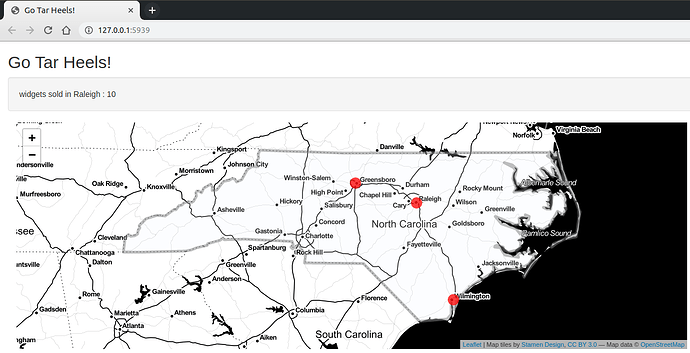Well, if no public dataset is available - we will have to make do with our ingenuity, and the good ol' NC shapefile from {sf} package.
It's a bird? It's a plane! It's the North Carolina shapefile!!!
library(dplyr)
library(shiny)
library(leaflet)
library(sf)
# NC counties - a shapefile shipped with the sf package
shape <- st_read(system.file("shape/nc.shp", package ="sf")) %>%
st_transform(shape, crs = 4326) %>%
mutate(widgets = 300) %>% # a column of fake data
group_by(widgets) %>%
summarize()
# three cities - note the x and y coordinates
points <- data.frame(name = c("Raleigh", "Greensboro", "Wilmington"),
x = c(-78.633333, -79.819444, -77.912222),
y = c(35.766667, 36.08, 34.223333),
widgets = c(10, 20, 30)) %>%
st_as_sf(coords = c("x", "y"), crs = 4326)
# create unique ids for both data sets
shape$uid <- "P1"
points$uid <- paste0("M", 1:3)
# Define UI
ui <- fluidPage(
# Application title
titlePanel("Go Tar Heels!"),
verticalLayout(
# Top panel with widgets sold
wellPanel(
textOutput("widgets")
),
# the map itself
mainPanel(
leafletOutput("map")
)
)
)
# Define server logic
server <- function(input, output) {
output$map <- renderLeaflet({
leaflet() %>%
addProviderTiles("Stamen.Toner") %>%
addPolygons(data = shape,
fillColor = "aliceblue",
color = "grey",
layerId = ~uid) %>% # unique id for polygons
addCircleMarkers(data = points,
fillColor = "red",
color = NA,
radius = 10,
fillOpacity = .75,
layerId = ~uid) # unique id for points
})
# click on polygon
observe({
event <- input$map_shape_click
message <- paste("widgets sold in North Carolina:", shape$widgets[shape$uid == event$id])
output$widgets <- renderText(message)
})
# click on a marker
observe({
event <- input$map_marker_click
message <- paste("widgets sold in", points$name[points$uid == event$id],":", points$widgets[points$uid == event$id])
output$widgets <- renderText(message)
})
}
# Run the application
shinyApp(ui = ui, server = server)
Note that since the observed events for a polygon clicked and a marker clicked are separate (which I did not fully realize when writing my earlier post) is is not strictly necessary to do a fancy compounding of layer_id's.
